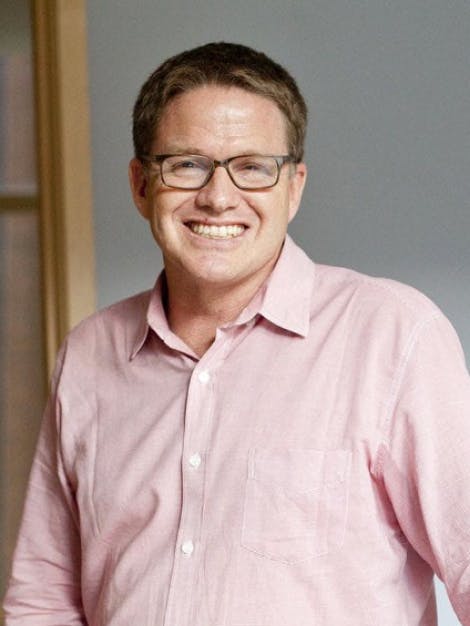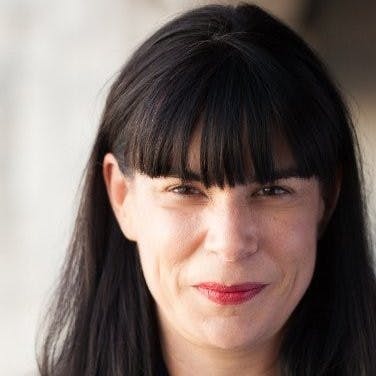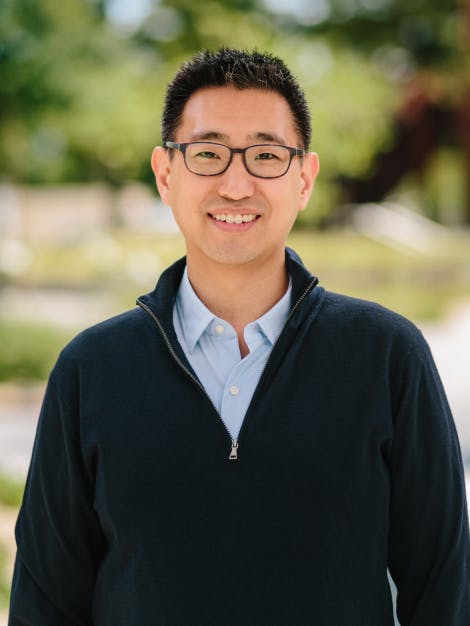Season 5 - Episode 4
Solving Human Behavior Problems
Tatyana Mamut is the CPO & Head of Product at Nextdoor. She is a result-oriented executive that has delivered outstanding products. In this podcast, Tatyana talks us through all things related to product, leadership, diversity, and how to solve human behavior problems.

Watch the episode here: Solving Human Behavior Problems
“Question [00:01:00] Tell us about your own personal story?”
Tatyana [00:01:01] Well, if you want to start at the beginning, we would have to start in Eastern Ukraine where I was born. I was born into an interesting family. My father’s family was Jewish. My mother’s family was Russian. Every one of my family was an engineer. My mother was an engineer. My father was an engineer and my grandmother was an engineer and we lived in a one-room communal apartment, which meant that we didn’t have a kitchen or a bathroom in our apartment.
We lived in kind of a dorm room kind of situation, the whole family in one room. We immigrated as political refugees when I was four years old with my family, my grandfather had been imprisoned under Stalin. And so when the United States was starting to let in Russian Jews who were political refugees, we were one of the first families who came.
We lived in New York. We lived in section eight, housing on welfare for a while until my parents learned English and found a little bit of English and found a job there, my father still doesn’t speak English.
I think that has shaped a lot of how I think about products. I come to product development from a truly global perspective from the very beginning. My parents were very, very, very disappointed that I did not become an engineer. and I was the black sheep in the family. My brother thankfully became a software engineer. So, at least they had that going for them, but I was more, always more interested in human beings and how humans worked as opposed to how machines worked. The human system, especially human society is just as interesting a product to me.
In many ways as any kind of mechanical or manmade thing. So I always wanted to learn about social studies, human interaction, economics. And so I became an economics major in college, which my parents were kind of okay with because as long as there was a lot of calculus and mathematical modeling, they were okay with my major in college. And I wanted to be an investment banker, so I was an intern on wall street for two summers and I loved the work but I really did not like the culture. I just did not meet a single person on wall street that I aspired to be like, to be quite frank. This the mid-1990s. This was a lot of the time when investment banking was coming into its own. It was becoming like the smartest guys in the room type of culture, and that culture just did not appeal to me at all.
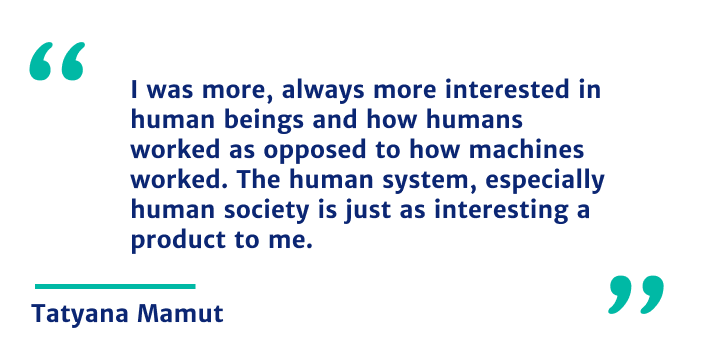
Ironically, I went into advertising after college and into global advertising and I worked at a global ad agency called Leo Burnett where I worked in Chicago, London, and then went, they sent me to Moscow to lead brand planning in Russia. And this was the early two thousand right after the financial collapse in Russia. And Russia was starting to think about how do we develop meaningful, brand experiences, in order to connect with the Russian market and the Russian culture in a unique way. Before that, a lot of advertising in the Russian market was focused on taking ads from the United States or from Western Europe and simply dubbing them into Russian. And that didn’t really work very well. I founded the brand planning discipline, which was around understanding, the culture, understanding Russians, and then taking that insight and translating it into a communication strategy, and then working with our clients. Procter and Gamble was actually my biggest client in Russia. Working with our clients to really craft the right brand messages, the right communications, and also start to adapt the products themselves for the Russian market.
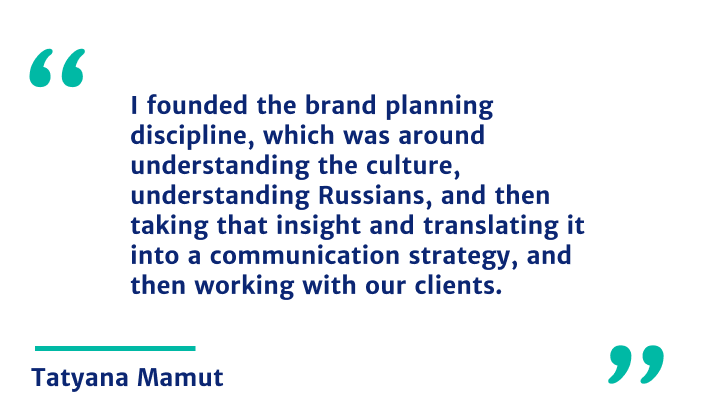
So some of the things that we found were just for tide detergent, right? Our experience of Tide detergent in the United States is so inappropriate for Russia. What we do is we get into our big SUV, we drive to the Costco, we buy a five-gallon tub of Tide. We put it back in our SUV, we bring it downstairs to our basement. And then we wash our clothes in our large personal washing machine. That is not how Russians live. Most Russians don’t have a car. They shop for their groceries and for their everyday items at a local kiosk. The kiosk is literally the size of a room. It’s not a huge supermarket and everything that they bring home, they have to carry by hand in a satchel to a large apartment building, go up several flights of stairs, often carrying the bags, and then what many of them, at least at the time I was there still wash their clothes by hand.
So tie the Ted product needed to be fundamentally rethought, redesigned repackaged repriced. And then again, only then could we figure out the right, advertising to really bring into the Russian market. It was that understanding of how human culture, human needs, human context fits in with product development that brought me to IDEO where of course is one of the very large innovation agencies. And by very large, I mean a couple of hundred people around the world. But it was an incredible place where there was a ton of creativity. Our clients came to us trying to like create the new innovative products.
I joined IDEO in 2007 when the iPhone came out. And so it was a really exciting time to be because all of a sudden our clients started asking not for hard products. Not mechanically engineered products, not electrically engineered products, but products that were fundamentally digital and digital-first in their experience. There weren’t a lot of people at IDEO at the time who knew a lot about digital experiences. I had been lucky enough to have been the first, Project Manager. I think that we called a Project Coordinator at the time at Leo Burnett, to create the overnights first website, the first website ever in 1997. We started building Leo Burnett, very first website. And I was the project manager on that and I kind of knew something about digital stuff. And so I raised my hand and I said, I’ll lead these big digital projects. And so I started leading digital projects for, visa for, Genentech for very large global companies and leading these projects around the world.
You might be interested in: Using Milestones in Agile Product Management
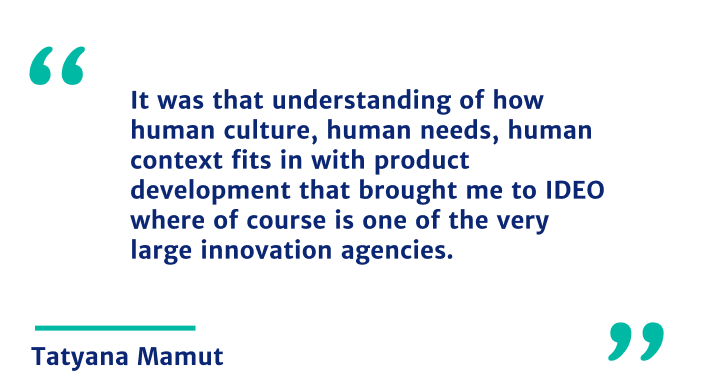
Then I was involved with The Bill and Melinda Gates Foundation to help figure out strategies for mobile money adoption around the world, as well as with the Institute for money technology and financial inclusion at UC Irvine. Then I started the organizational design practice at IDEO where I really worked with organizations and CEOs to help transform their companies to be more innovative. So instead of kind of hiring IDEO to create the innovation project and then being like, okay, client, you’re on your own to develop it. Our practice really focused on what we called change by doing right. Partnering with organizations to not just design the products, but to see the organization as a product itself that we could redesign so that the people, the processes, the systems became more innovative so that when IDEO stepped out the organization could continue the product innovation on its own.
I did that for several years, there was a lot of great experience that really helped to transform several companies. One of which had a huge acquisition exit, based on their innovation premium, by the time they’d been, working with IDEO for awhile.
Then I went to Salesforce. So Salesforce in 2014 was looking for someone to help lead a design-led transformation and its product. And so I came in, in a very strange role, and then ended up the lightning experience redesign, which was the biggest redesign of the Salesforce product in its history. That was between 2014 and 2016. You can see where their Salesforce product has gone from that. Everything now is pretty much lightning experience, and that was a great opportunity. And then Salesforce was investing in new technology and new products, the internet of things, cloud IoT cloud.
I was the first front-end leader that was brought into that kind of technology that has been built on the backend. And then there were like, well, what is this user experience is going to be? What would the front end look like? And so I started in the design world at Salesforce, but then coming over to the IoT cloud, we really needed someone who was not just as design leader, but also who can actually lead the front end product vision as well. So I started taking on more and more product responsibilities, and then interestingly, a few of the Product Managers on my team raise their hands and said they wanted to report to me.
So then I started managing Product Managers, which was awesome. And then I went over to AWS because the person who I’d been working for on IoT cloud, went over to AWS to start something new. And I was like, well, this sounds exciting – like can I come with you? And so he was like, yes.
He and I wrote the first peer FAQ for what is now Honeycomb it’s launched. I can talk about it now. And, it was AWS’s foray into going beyond developers who could code and building a product for business users. So we wrote the PR FAQ, put together the product plan, got the resources together, grew the team from the two of us to 150, in a year and a half. And then I managed at AWS the entire front-end team. So design Product Management, and also front-end engineering, which was a really interesting experience for a non-engineer. But, I learned a ton and I did an okay job in that a lot of the engineers who worked for me, you know, still continue to reach out and say, “Hey, you know, do you have anything interesting at Nextdoor? I’d be really interested in working, with you or for you again.” So that, you know, seems to have worked out Okay.
After AWS I started to really think about, new technologies, emerging technologies, especially blockchain, like left. It was, you know, early 2018 to advise a couple of blockchain companies. And then I had this incredible opportunity to join next door. So joined Nextdoor and I’ve been there for about a year and a half.
So one of the things about, my career is always being there and always raising my hand and saying, I will figure this out. Even if I’m not an expert right now, if there isn’t an expert in the room, I will be the one to figure it out.

I also think the other thing about me and my perspective, is that I really think the hard problems in technology today are not fundamentally technology problems. They’re human problems. There are human behavior problems, right?
How do you build a product that people will love and how do you bring together a team that will work together to build that thing, right? Those are the hard problems that we are here to solve as product leaders. I’ve always had great technology partners, right? Great VPs of engineering and great CTOs that I’ve partnered with, who can solve those problems, but as product people, our biggest, hardest problems are the human problems.
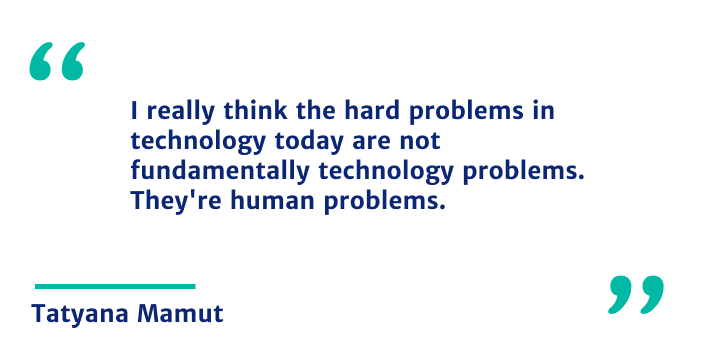
“Question [00:15:40] What do you do on a day-to-day basis?”
Tatyana [00:15:13] At the high level, what I do is I ask a lot more questions than I provide answers. My job is to really not to come up with the what should we build anymore, right. The reason a lot of people went into Product Management is that they are very passionate about the, “what should we build?” Right. When you’re at the level that I’m at now, it’s less about “what we should build?” And more about the, “why are we building what we’re building?” Or “why are we prioritizing what we’re prioritizing?” It’s about, who are the right people and the right teams to really get us to our organizational goals, and to our company goals.
It’s the when question, “how do I set deadlines appropriately for my team?” So that they have the right constraints. So they’re not too constrained, right. They can still think big. They can still go after the big ideas, but they’re constrained enough so that they’re executing at the highest efficiency possible, right?
Those are the questions that I focus on as a CPO. It’s really who is on the team? Do I have the right people on the team? Have I given them the right deadlines? And am I asking the right questions about why are we doing this? Who are we creating this for?
And when the teams bring me an idea, I ask those questions again, who are we designing this for? Why do we know that they will value this? How will we monitor the progress toward the goal? How will we know we’re successful? So again, it’s as you move up the trajectory and your product career, you focus less and less on the, what, the specific what’s and you focus more and more on these other questions.

“Question [00:17:50] How do you make sure that when you’re asking those questions, it is the CPO at Nextdoor and not Tatyana who is the product person who loves using the product?”
Tatyana [00:18:00] I will be completely honest. It is really, really, really hard. I do dive very deep sometimes with my teams. Our product development process includes a couple of places where I get to be creative and intervene as well. So we develop insights, we write PR FAQ drafts. The PR FAQ is the press release and frequently asked questions. It’s a take on Amazon’s process for customer-obsessed product development. We don’t write PRDs or MRDs. We write pure FAQs.
And then we do a Charrette – which is a collaborative cross-functional work session where we bring together Product Managers, Designers, the Insights team, the Marketing team, the Go-to-Market, the Revenue team, the Engineers, right. To really think about what kind of ideas can we build that really meet these jobs to be done of our customers that we’ve identified in the early research.
Then we go into the deeper experimentation and, deeper peer FAQ writing the spec writing and all of that and the UX design. And so I get to intervene in the Charrette. So I’m always like – are you having a charrette? Make sure I’m included. I’m just a participant in the charrette, but I get to insert my ideas just as an equal.
And then the other place, even before that, in the insights phase, I spent at least two days a month actually running our research. So the insights team is pretty small and I help augment them. So our head of insights will often put me to work, and hand me a discussion guide.

Pre-COVID, I would go out and travel to, Sweden, Denmark, Atlanta, Santa Monica or Oakland, wherever they wanted to send me. And I would actually conduct the research. One of the reasons why, is I want to continue to keep my empathy for our customers and our members really top of mind, and really fresh. And from that, I can have more product intuition. So I spent at least two days a month doing that.
And then the other place where I get to intervene as in the peer FAQ. So we have peer FAQ reviews together as a product team, for any new feature that’s being developed, we review it all together as a team. So I’m a voice- I’m a fairly strong voice in that process. And every once in a while, I will just throw in my own PR FAQ if I have an idea. So I will bring it to my product team just as any other Product Manager would.
Check out: How User Insights Can Fuel Innovation for Product Teams
“Question [00:21:06] What is your philosophy around building a great product?”
Tatyana [00:20:11] A product is a place that I believe needs to hold empathy at the highest level. And what I mean by empathy is empathy for users, customers – if users and customers are different groups, but then also empathy for the different functions in an organization to really understand how to build a product, right. Also what product to build, but also how to bridge the empathy gap and how to build the right product.
The way that I construct product teams is based on a rule of thirds. One-third, one-third, one-third. So many product teams have folks with an engineering background who really understands the technical sides of how to find the right product to build. So I do have on my team about a third of my Product Managers who have some sort of technical background to really help the team understand when we’re reviewing the PR FAQs. They’re the voices that really advocate from a technical perspective.

A third – I have people with business backgrounds, right. To really understand the business model and the business implications of any product that we’re willing to build. And again, in the reviews, like those people partner with the other Product Managers to really understand kind of the tech, the business in and outs of how to make a product successful.
And then the other third, and I would say, this is the secret sauce of my product teams. And if your product teams aren’t aligned this way, I would inspire you to think about what you might be missing are social scientists. So people with anthropology, sociology, history, degrees. Those social sciences are incredibly important because they help understand and have extremely important technical knowledge around how human behavior and motivations work so they can help other Product Managers understand how to focus, hone, and design their product experiences. This way they have the best chance of adoption and usage because that’s really what is all about.

Earlier this morning, our product team discussed Mark Granovetter’s work on the Strength of Weak Ties. One of our Product Managers with a background in Sociology presented that, and that is going to help us understand and unlock a lot of our thoughts around what kind of products can we build to unlock the power of weak ties in a neighborhood and in a social network environment. So that’s how I think about creating product teams, a third, a third and a third.
So a lot of our designers actually also have a sociology or anthropology background. I do have designers with that background come into product management, but it’s the understanding of humans that we’re looking for in that third.
It’s so funny to me because I have a Ph.D. in anthropology, and it’s funny how people think that they understand humans just because they’ve been human beings and have been around humans. That would be like my 10-year-old saying that she knows a lot about, iOS development because she’s been using an iPhone for the last few years. Just because you use an iPhone doesn’t mean, you know really the mechanics and the deep understanding of how this works.
And so Anthropologists, Sociologists, Social Scientists have a deep understanding and a lot of knowledge around how human beings behave and what makes for human desirability of different product experiences. And how to set up products for the best chance for adoption that you don’t just don’t get just by being a human being. So it’s not just about influence within an organization, it’s actually designing the right product, because unless you’re designing your product only for the adoption by other technologies. If you’re designing a product for people who need to buy and use it, you need to have partners at least, or use self need to have an understanding of human beings and how to create human desire.
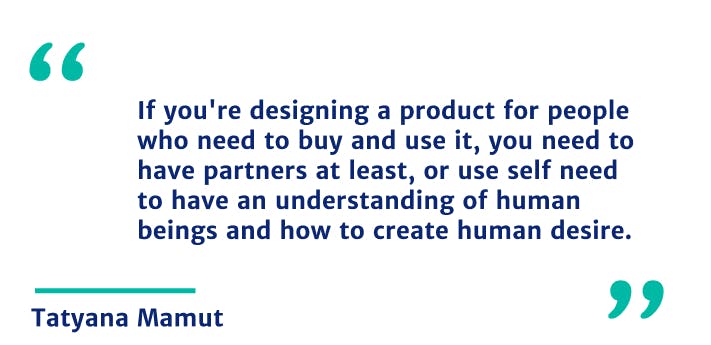
“Question [00:26:30] Is there any difference in that mix or anything else when you build B2B products versus B2C?”
Tatyana [00:26:38] So I have crossed the threshold many times between B2B and B2C. And I can tell you from experience, there is very little difference. There’s some difference in kind of the implementation, the AB testing. There are a lot more constraints on AB testing in a B2B environment in many ways, other than that, as long as you’re designing a product for people.
As long as people are your customers and users, the processes and methodologies that work for designing a product that is adopted and used within a work context are very similar to the frameworks and the thinking and the process for creating products that are designed and used in a personal life process. But you need to have people who understand how to model those lifeworlds slightly differently because, in an organizational environment, there are going to be different systems of adoption versus in a personal environment. So you just need people who understand how to model out those different cultural systems. And then it’s pretty much the same.
Check out: Bridging the Gap Between Users, Technology and Business
“Question [00:27:59] When it comes to your leadership style, who did you learn from, and what are some of the highlights that you think are important for great leaders?”
Tatyana [00:28:11] So I was exceptionally lucky, I had the two most incredible bosses coming out of college at Leo Burnett who continue to be my mentors and friends today. T.Scott Edwards – I’ll just call them out by name because they’re so fabulous – he became the CMO of HP and Gateway Computers – a pretty amazing person.
I remember one of the very first meetings I had with him, I was 22 years old had just been out of college. I was on the business development team. So I was one of the people who was running new business pitches all the time. And I was taking notes, right, because I’m like a young person. And then after the meeting, I said to him, I had an idea for how we can actually develop this ad. And he said the next time you have an idea like that, and you don’t say it in a meeting you’re fired. But like his point was like, speak up in the meeting. Anytime you have something valuable to say, don’t, self-censor, don’t silence yourself, speak up. And so that was incredible.
He then introduced me to my second boss, Brenda Williams, and she ran a brand innovation studio and consulting firm within Leo Burnett. And she is just, she’s a force of nature. She is brilliant and outgoing, and again, she would just push me. She would just throw me into situations, knowing that I had no expertise in the area. She threw me when I was again, 24 years old.
We had a big workshop with Kellogg’s executives and I had never run a workshop before. And she was like, I need you to run a workshop. And I was like, I don’t, I mean…this is like – the CEO of Kellogg’s is coming like, how am I gonna run this workshop? She’s like, you’ll figure it out. And she would just like, again, throw me in. I mean, she would give me the tools and, she was very supportive and very helpful, but just throw me in the deep end, throw me in the deep end and see when I would sink. And I didn’t sink. And it’s a lot because of her and her kind of confidence in me.
I think that human connection is an important thing. Yes, we need to network and all those types of things, but people are valuable in and of themselves, regardless of the position that they’re in. When you find someone that you really connect with and that shares a worldview with you. I mean, hopefully, you’ll be helpful to each other, but even just having that support from the other person is really helpful. So stay connected at a personal level.

“Question[00:32:00] What’s next for you in terms of learning?”
Tatyana [00:32:05] I am curious about all things. My curiosity around blockchain – the reason I left AWS and went into blockchain was a very different moment. I actually think that back in 2017/2018 was kind of like blockchain was kind of like the internet was, and in the very early nineties, nobody knew what to do with this new thing. I still see a lot of very interesting use cases springing up everywhere around blockchain. And I do think there’s the potential for the creation of completely new business models, unlocking blockchain. One of the most interesting companies I know right now is – other than Nextdoor, of course – is Brain trust. So if you don’t know it, it’s usebraintrust.com and they’re really creating based on a blockchain-based system.
A new way for people to take control of their financial lives and their careers. It’s hard to describe because it’s not gig economy, it’s not freelance work. It’s a way for highly skilled people to take on projects and actually have something that feels like a career project-based work, but really be in control of the time of their place. And also earn equity in the network through this blockchain system, which is unique. Which has a lot of freelancers, especially developers, Product Managers, Designers. The value that you get, if you go to a big tech company is you get the equity, you don’t get that. If you get the freedom as a freelancer, but you don’t get the equity, this is actually bridging those two things. So again, I just think, blockchain is really nascent. It still needs a lot of unlocks to find out what is the real value that we can create with this new technology. And it’s a place that I still spend a bit of time on.
“Question [00:34:18] What do you do to make the workplace more diverse and inclusive?”
Tatyana [00:34:24] We think about this a lot and we kind of push on this a lot. So at the foundation, I think it’s incumbent on us as Product Leaders to make sure that the people making decisions about the product reflect the people that we are serving and both current and future customers. It’s a business decision to make sure that we have those views represented of the people who are our current customers and our future customers on our product team and not just on our product team but making the critical decisions around the product. And so that’s fundamentally the philosophy that I bring into hiring. Do I have the perspectives on the team to make the right decisions for the product both now and in the future? And where we strategically know that we want to go.
And where we strategically know that we want to go. So, you know, we’re a global product. Next door is a global product. We’re in 11 countries around the world. And so it’s critically important that we have a very global perspective. And fortunately, we do even just on my product leadership team, our heads of product across our different areas. There’s a lot of diversity, there are people from Latin America, Europe, Asia – there are people with very different backgrounds. That includes racial diversity, socioeconomic diversity, people from very different financial backgrounds, which also includes geographic diversity. Making sure that we have people who understand how cultures are different around the world. So that when we’re making those product decisions, that knowledge comes into the room, or else the decisions are going to be myopic.

I think you do need to make sure that you have a diversity of gender race, socioeconomic status, or backgrounds, as well as geographic diversity, right. People from different countries, different cultural conceptions. If you just look at the United States, you can, you can see right. That there is a divide in terms of how people think in the United States, how people perceive the world in the United States. And so it’s really important for me to make sure that we had at least a few people from the American South, on the product team and making a very high-level product, and not just on the product team, but like we’re product decision-makers right, because without that background and that deep empathy and that deep understanding, you just don’t have the person in the room.
I especially thought it was important to folks from African-American backgrounds to make critical product decisions in the room because otherwise, how would we even know what we don’t know? And so I do think it’s really critically important to understand that when you look around the room, that the people who are making decisions in the conference room look, speak, think, have empathy for the people that are your customers and that you want to be your future customers. But that is very, very important.

“Question [00:38:58] How would you encourage people who don’t have the title and think that don’t deserve to share ideas to take one step forward and try to position themselves and add value?”
Tatyana [00:39:15] I think that’s a hard one. I mean it’s not that I haven’t faced setbacks. I’ve faced some discrimination, some harassment in my background. So I definitely understand what it feels like to feel intimidated, to be the only woman in the room to be the only female voice in the room for years often. And how much that weighs on your ability to speak up how much that fact alone, creates a context in which you would just rather not speak up at all, because you just don’t know what the response will be. Often it’s even worse when you’re ignored, even if you’re not attacked. So I get that.
There are two things that I would say, one, try to find an ally who is often in the room with you, who will help amplify your voice. Can you find someone, it can be a man? Absolutely. I’ve had a situation several times where a man in the room has said, had said, like, and what she said, I agree with, let me restate it again in my masculine voice so that the rest of you will hear it. I’ve definitely seen that happen. And that in fact has happened to me in the past with a male VP who would do that again and again and again, when he felt that my voice was not heard in the room, he would let me make a point. And they’d be like, Oh, that’s a really good point. And be like, yeah, Tatyana just said that.
So try to find an ally, try to work with that person, someone who really believes in you, who’s on your team. Maybe your boss, maybe it isn’t, but somebody who’s an ally who will amplify your voice and see if that helps.

The other thing is writing long emails. This is one of the other things that I did is, when I had a point of view and I felt like I was not being heard sometimes in a meeting, you have like a few seconds of conversation because you don’t want to take up the whole space and right a long email. And really read that email, again and again, make sure it’s really great, and then send it off to the decision-makers. That can be incredibly effective if the verbal communication isn’t working, and you are getting drowned out or you feel uncomfortable. Try email communication, but make sure those emails are really great.
And finally, if nothing is getting through and you not confident that the environment is not one that is conducive to including your voice, look for another job. I mean, honestly, the world is big. Everyone needs great talent. So if you’re not being appreciated where you are, the world, the world is your oyster, right? You are valuable and you provide valuable perspective, find a place that will value that perspective, and that will value your voice.
“Question[00:42:34] Is there anything else that you would like to add?”
Tatyana [00:42:38] One of the things around product is, you know, it’s our responsibility we’re creating the future, right? Product Management is the function that is building the future, because so much of the future, almost all of it is going to come through technology in one way or the other. So please take that responsibility seriously. Please think about our ethical responsibilities. What is the type of future that you are building in your day-to-day job and really come at it from that perspective?
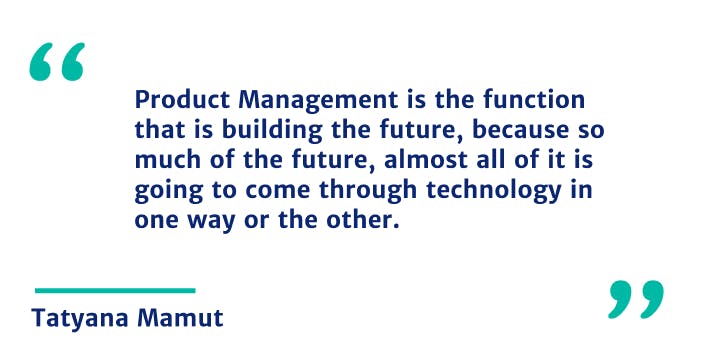
We’ll be back again next week with Joff Redfern from Atlassian with even more of the latest insights from the Product Management world. Stay tuned for more!
Listen to our episodes on your favorite platform
Stay tuned for new episodes
By sharing your email, you agree to our Privacy Policy and Terms of Service

